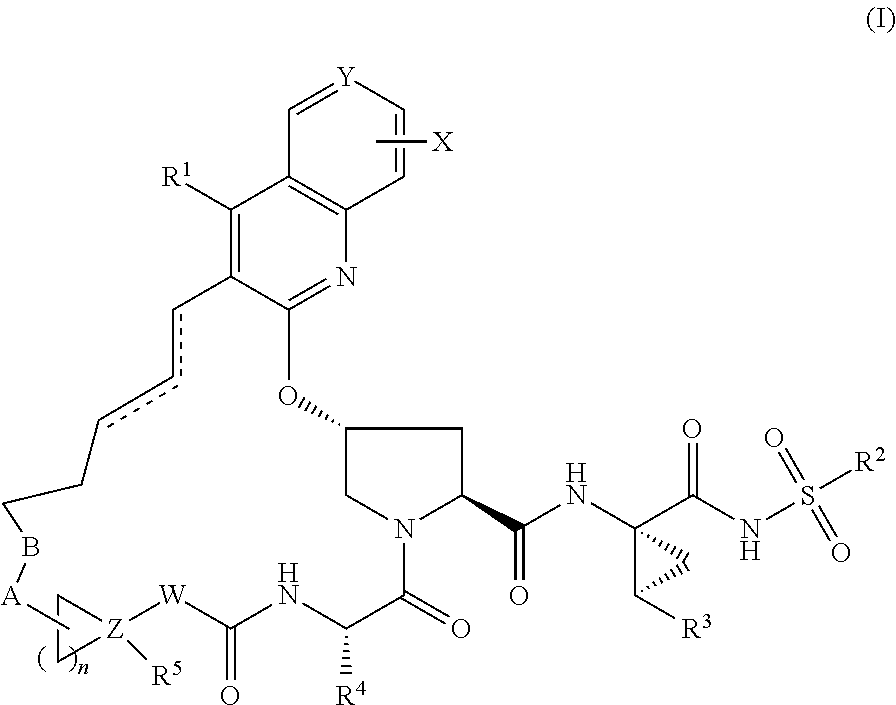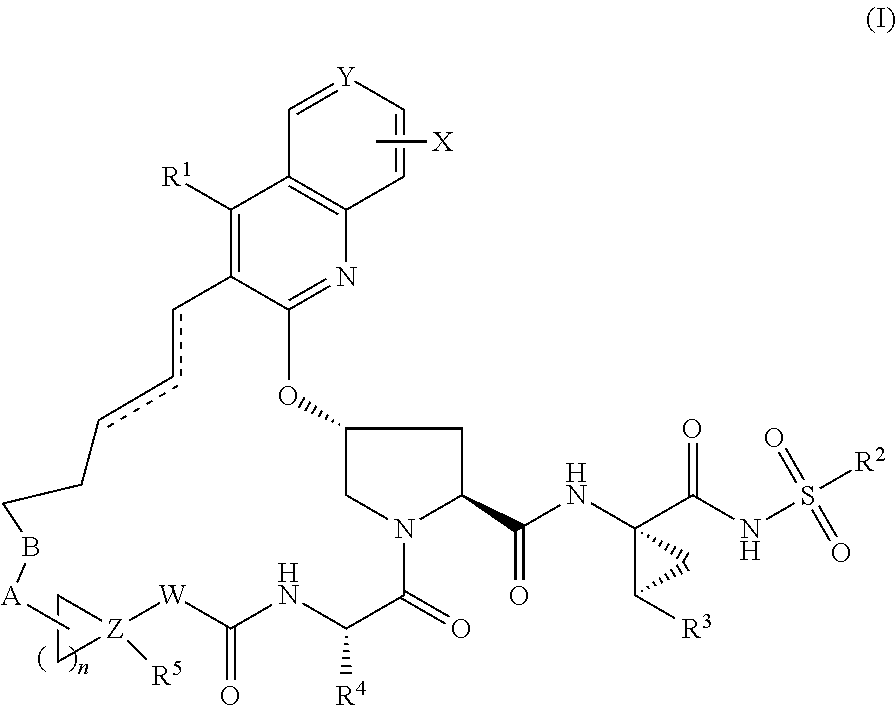Hcv ns3 protease inhibitors
a protease inhibitor and hcv technology, applied in the field of macrocyclic compounds, can solve the problems of limited clinical benefit, no established hcv vaccine, and treatment of hcv infection, and achieve the effect of reducing the likelihood or severity of one or more symptoms
- Summary
- Abstract
- Description
- Claims
- Application Information
AI Technical Summary
Benefits of technology
Problems solved by technology
Method used
Image
Examples
example 1
(3aR,7S,10S,12R,21E,24aS)-7-cyclopentyl-N-{(1R,2S)-1-[(cyclopropylsulfonyl)carbamoyl]-2-ethenylcyclopropyl}-19-ethoxy-5,8-dioxo-1,2,3,3a,5,6,7,8,11,12,20,23,24,24a-tetradecahydro-10H-9,12-methanocyclopenta[18,19][1,10,3,6]dioxadiazacyclononadecino[11,12-b]quinoline-10-carboxamide
[0381]
Step 1: 1-tert-butyl 2-methyl(2S,4R)-4-{[4-ethoxy-3-(prop-2-en-1-yl)quinolin-2-yl]oxy}pyrrolidine-1,2-dicarboxylate
[0382]
[0383]To a mixture of 1-tert-butyl 2-methyl(2S,4S)-4-{[(4-bromophenyl)sulfonyl]oxy}pyrrolidine-1,2-dicarboxylate (1337 mg) and Intermediate C2 (600 mg) in N-methyl-2-pyrrolidinone (12 ml) was added cesium carbonate (2558 mg) and the mixture was stirred at 60° C. for 1 hour. The reaction was not complete and additional brosylate (250 mg) and cesium carbonate (450 mg) were added. The mixture was stirred at 60° C. for 1 more hour. The reaction mixture was then cooled before quenching into water (150 mL) and aqueous KHSO4 (pH=3.5). The product was extracted into ethyl acetate (150 mL). T...
examples 2-16
[0394]By following the procedures outlined in Example 1 and using the appropriate A, B and C intermediates and indicated reaction schemes (depicted below the structure as Int. and Rx., respectively), the following compounds were prepared.
LRMSorHRMSExStructureName(M + H)+2 Int. A5, B2, C2 (3aR,7S,10S,12R,21E,24aS)-7-cyclopentyl-N- {(1R,2R)-1-[(cyclopropylsulfonyl)carbamoyl]-2- ethylcyclopropyl}-19-ethoxy-5,8-dioxo-1,2,3,3a,5, 6,7,8,11,12,20,23,24,24a-tetradecahydro-10H-9,12- methanocyclopenta[18,19][1,10,3,6] dioxadiazacyclononadecino[11,12-b] quinoline-10-carboxamide820.33 Int. A1, B2, C2(3aR,7S,10S,12R,21Z,24aS)-7-cyclopentyl-N- {(1R,2S)-1-[(cyclopropylsulfonyl)carbamoyl]-2- ethenylcyclopropyl}-19-ethoxy-5,8-dioxo-1,2,3,3a, 5,6,7,8,11,12,20,23,24,24a-tetradecahydro-10H- 9,12-methanocyclopenta[18,19][1,10,3,6] dioxadiazacyclononadecino[11,12-b] quinoline-10-carboxamide818.24 Int. A1, B2, C1(3aR,7S,10S,12R,21E,24aS)-7-cyclo pentyl-N- {(1R,2S)-1-[(cyclopropylsulfonyl)carbamoyl]-2-...
example 17
(3aR,7S,10S,12R,21E,24aS)-7-cyclopentyl-N-{(1R,2S)-1-[(cyclopropylsulfonyl)carbamoyl]-2-ethenylcyclopropyl}-19-hydroxy-5,8-dioxo-1,2,3,3a,5,6,7,8,11,12,20,23,24,24a-tetradecahydro-10H-9,12-methanocyclopenta[18,19][1,10,3,6]dioxadiazacyclononadecino[11,12-b]quinoline-10-carboxamide
[0395]
[0396]Example 8 (19 mg) was treated with TFA (1 ml) in a sealed tube and warmed to 55° C. After 30 minutes, the reaction was concentrated and the residue was dissolved in ACN and purified by reverse phase HPLC to provide the desired product as a white foam (13 mg). LRMS (ES+) m / z (M+H)+ 790.2.
PUM
| Property | Measurement | Unit |
|---|---|---|
| pH | aaaaa | aaaaa |
| volume | aaaaa | aaaaa |
| temperature | aaaaa | aaaaa |
Abstract
Description
Claims
Application Information
 Login to View More
Login to View More - R&D
- Intellectual Property
- Life Sciences
- Materials
- Tech Scout
- Unparalleled Data Quality
- Higher Quality Content
- 60% Fewer Hallucinations
Browse by: Latest US Patents, China's latest patents, Technical Efficacy Thesaurus, Application Domain, Technology Topic, Popular Technical Reports.
© 2025 PatSnap. All rights reserved.Legal|Privacy policy|Modern Slavery Act Transparency Statement|Sitemap|About US| Contact US: help@patsnap.com



